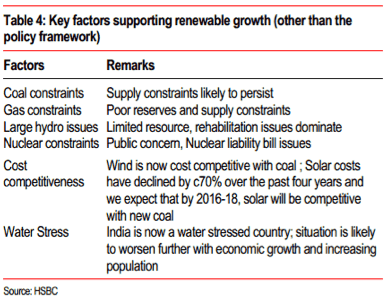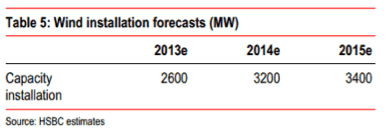Wind at parity with new coal in India, solar to join by 2018: HSBC
By Sophie Vorrath on 11 July 2013
The report on India Renewables, Good bye winter, hello spring, published on April 30, says the growing cost-competitiveness of renewable energy with new-build coal – and the arrival of wind parity, despite the upper wind FiT range being around 15 per cent lower than the upper tariff range for new coal capacity (see chart 3 below) – is helping to drive strong renewables growth on the sub-continent.Wind energy is now cost competitive with new-build coal capacity in India, and solar is likely to follow suit sometime between 2016-18, according to a report by HSBC.
India’s share of renewable generation in the total electricity mix increased to around 6 per cent in the 2012/13 financial year – an amount the government is hoping to grow to 20 per cent by the end of 2020, to help meet the nation’s a peak power deficit of 12GW, or around 9 per cent of its demand.
“With electricity demand expected to grow and conventional power capacity facing its own challenges, we expect developers and investors to favour renewable capacity addition,” says the report, pointing to increasing constraints on new-build coal, gas and nuclear, as well as increasing levels of water stress.
 “Coal stress has been a key driver of renewables in India,” says the report. “We now see water stress as also supporting renewables growth. For the third consecutive year in a row, some coal-based capacity has been closed down during the pre-monsoon period driven by water shortages. We note that thermal power generation is the largest water consumer within the industry segment in India.”
“Coal stress has been a key driver of renewables in India,” says the report. “We now see water stress as also supporting renewables growth. For the third consecutive year in a row, some coal-based capacity has been closed down during the pre-monsoon period driven by water shortages. We note that thermal power generation is the largest water consumer within the industry segment in India.”
For wind, favourable policy support mechanisms, such as increased state tariffs (although most remain well below coal tariffs, as mentioned – chart 3) and the expected 2014 reintroduction of the government’s Generation Based Incentive for wind energy projects, are expected to help deliver what some say could be a potential capacity of more than 100GW to a few hundred GW – well above the 50GW the Indian government has long been forecasting.
 “Over the past 12 months, across key wind states, except Karnataka, the wind tariff has been raised,” says the report. “Six key states – Andhra Pradesh, Gujarat, Madhya Pradesh, Maharashtra, Rajasthan and Tamil Nadu – have increased tariffs in the range of 2-36 per cent,” it says, while Karnataka’s wind tariff is due to be reviewed next year, and a few other states, like Kerala, have also increased tariffs.
“Over the past 12 months, across key wind states, except Karnataka, the wind tariff has been raised,” says the report. “Six key states – Andhra Pradesh, Gujarat, Madhya Pradesh, Maharashtra, Rajasthan and Tamil Nadu – have increased tariffs in the range of 2-36 per cent,” it says, while Karnataka’s wind tariff is due to be reviewed next year, and a few other states, like Kerala, have also increased tariffs.
No comments:
Post a Comment